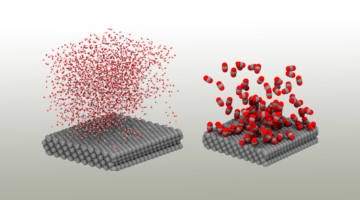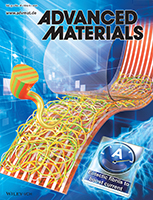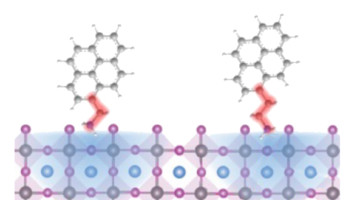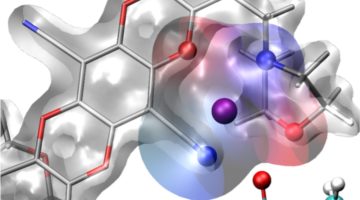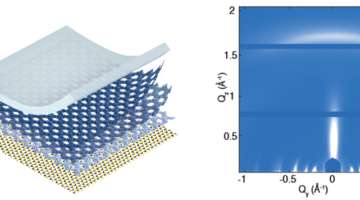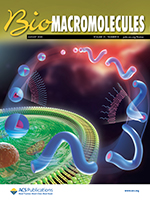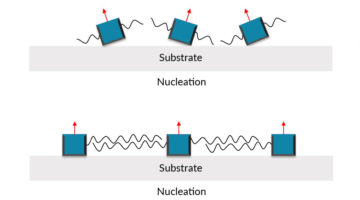A new solar material, organic-inorganic halide perovskites, could one day help the U.S. achieve its solar ambitions and decarbonize the power grid. A recent study reports that manufacturing could be aided by a new instrument that uses invisible x-ray light and visible laser light to probe a perovskite material’s crystal structure and optical properties as it is synthesized. Read more »
Exquisitely Selective CO2 Reduction on Silver
Researchers electrochemically reduced CO2 to CO with nearly perfect selectivity over other products by adding an organic compound to the surface of a silver electrode. With theoretical analyses and ALS data, the work revealed the key role of the microenvironment in promoting the conversion of CO2, a greenhouse gas, into useful products. Read more »![]()
![]()
High-Efficiency Organic Photovoltaics using Eutectic Acceptor Fibrils to Achieve Current Amplification
Researchers report the fabrication of ternary organic solar cells, achieving a significant JSC boost, by virtue of their optimized crystalline feature, with the formation of eutectic crystalline fibrils. The optimal morphology suppresses energetic disorder and nongeminate recombination, and increases charge transfer and transport, yielding a high efficiency of 17.84% with significant current amplification. Read more »
A Properly Tailored Tail Boosts Solar-Cell Efficiency
With the help of structural insights from the ALS, researchers optimized the fit between organic and inorganic ions in a perovskite solar-cell material. The work increased the material’s power-conversion efficiency and stability and opens up a new avenue for improving the current-carrier dynamics of a promising class of materials. Read more »![]()
![]()
Designing Selective Membranes for Batteries Using a Drug Discovery Toolbox
Researchers designed a polymer membrane with molecular cages built into its pores that hold positively charged ions from a lithium salt. These “solvation cages” increased lithium-ion flow by an order of magnitude and could allow high-voltage battery cells to operate at higher power and more efficiently, important for both electric vehicles and aircraft. Read more »
Stacking the Deck for Custom-Built Hybrid Materials
Researchers fabricated an electronically coupled heterostructure from a novel semiconducting 2D polymer and a 2D transition metal dichalcogenide. Dramatic optical and electronic changes emerged as polymer thickness decreased, underscoring the potential for the discovery of emergent phenomena in studies of hybrid heterostructures. Read more »
Functionalization of Benzotriazole-Based Conjugated Polymers for Solar Cells: Heteroatom vs Substituents
Understanding the structure-property relationship is important when designing new conjugated polymers for high-efficiency polymer solar cells. Rech et al. systematically explore the impact of a variety of functional groups, including nitrogen heteroatoms, fluorine substituents, and cyano groups. Read more »
Balanced Charge Transport Optimizes Industry‐Relevant Ternary Polymer Solar Cells
In this article, Szymanski et al. develop novel, cost‐effective ternary polymer solar cells printed in semi‐industrial conditions from a relatively benign ink, which do not require any further processing. These solar cells show good stability and efficiency due to balanced charge-carrier mobilities achieved by optimizing the composition and morphology. Read more »
Thermoinduced Crystallization-Driven Self-Assembly of Bioinspired Block Copolymers in Aqueous Solution
Thermoinduced crystallization-driven self-assembly of polypeptoid-based block copolymers results in delicate control over the nanostructure in aqueous solution. This provides a convenient platform for comparing cellular uptake efficiency of nanostructured assemblies with various morphologies that are otherwise similar. Read more »
Long Chains Stabilize Higher-Efficiency Solar Cells
Perovskite thin films have many attractive properties for use in photovoltaics, but their assembly into practical devices has led to trade-offs between efficiency and stability. The addition of surfactant-type molecules with hydrophobic chains helped produce perovskite solar cells that are both efficient and stable. Read more »

